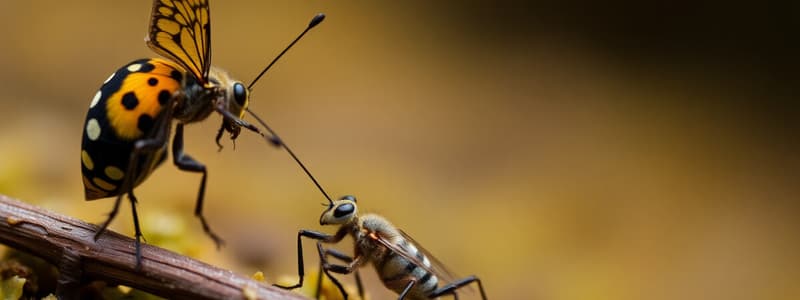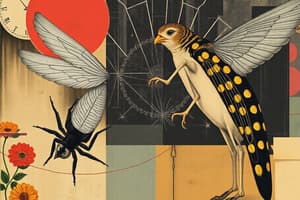Podcast
Questions and Answers
What is a defining characteristic of the association between Yeti crabs and Riftia pachyptila?
What is a defining characteristic of the association between Yeti crabs and Riftia pachyptila?
- Both are gutless organisms
- Both require sunlight for survival
- Both are found in association with deep-sea hydrothermal vents (correct)
- Both live in shallow waters
Which of the following is NOT one of the major types of symbiotic associations mentioned?
Which of the following is NOT one of the major types of symbiotic associations mentioned?
- Mutualism
- Parasitism
- Predation (correct)
- Commensalism
What is the primary benefit to herbivores from their bacterial symbionts?
What is the primary benefit to herbivores from their bacterial symbionts?
- Enhanced ability to photosynthesize
- Reduction in body mass
- Improved breathing efficiency
- Supplementation of nutritional needs (correct)
Which example illustrates a vertically inherited intracellular endosymbiont lifestyle?
Which example illustrates a vertically inherited intracellular endosymbiont lifestyle?
What is a major advantage of developing symbiotic relationships for multicellular life forms?
What is a major advantage of developing symbiotic relationships for multicellular life forms?
What type of association is represented by the relationship between Rhizobium and legumes?
What type of association is represented by the relationship between Rhizobium and legumes?
In what way can symbiotic microorganisms contribute to an animal host's survival?
In what way can symbiotic microorganisms contribute to an animal host's survival?
Which of these relationships would be classified as mutualism?
Which of these relationships would be classified as mutualism?
What type of symbiotic relationship allows both organisms to benefit?
What type of symbiotic relationship allows both organisms to benefit?
In which scenario does one organism benefit while the other remains unharmed?
In which scenario does one organism benefit while the other remains unharmed?
Which term describes a symbiotic relationship where one organism cannot survive without its partner?
Which term describes a symbiotic relationship where one organism cannot survive without its partner?
What characterizes facultative symbiosis?
What characterizes facultative symbiosis?
What is a key characteristic of Buchnera aphidicola in relation to aphids?
What is a key characteristic of Buchnera aphidicola in relation to aphids?
What role typically defines the host in a symbiotic association?
What role typically defines the host in a symbiotic association?
Which of the following is an example of ectosymbiosis?
Which of the following is an example of ectosymbiosis?
What is one main benefit of the symbiotic relationship between fungi and algae in lichens?
What is one main benefit of the symbiotic relationship between fungi and algae in lichens?
Which statement accurately describes the nutritional benefits of symbiotic relationships?
Which statement accurately describes the nutritional benefits of symbiotic relationships?
In what form can defense and protection benefits be provided in symbiotic associations?
In what form can defense and protection benefits be provided in symbiotic associations?
What is a characteristic of endosymbiosis?
What is a characteristic of endosymbiosis?
What is a primary factor that can affect symbiotic relationships over time?
What is a primary factor that can affect symbiotic relationships over time?
Which of the following types of associations involves clear cost/benefit analysis?
Which of the following types of associations involves clear cost/benefit analysis?
What is the primary nutrient that aphids obtain from the plant phloem?
What is the primary nutrient that aphids obtain from the plant phloem?
What advantage does Buchnera provide to the aphid host?
What advantage does Buchnera provide to the aphid host?
What factor has limited genetic exchange for Buchnera?
What factor has limited genetic exchange for Buchnera?
How do Rhizobium and Agrobacterium primarily differ?
How do Rhizobium and Agrobacterium primarily differ?
What type of relationship does Agrobacterium have with plants?
What type of relationship does Agrobacterium have with plants?
What is the estimated size of Buchnera's genome?
What is the estimated size of Buchnera's genome?
What ecological role do Rhizobium and Agrobacterium share?
What ecological role do Rhizobium and Agrobacterium share?
Which of the following statements is true about the nutritional mutualism between aphids and Buchnera?
Which of the following statements is true about the nutritional mutualism between aphids and Buchnera?
Which type of symbiotic relationship involves both partners benefiting but not being entirely dependent on each other?
Which type of symbiotic relationship involves both partners benefiting but not being entirely dependent on each other?
In the relationship between Euprymna scolopes and Aliivibrio fischeri, what advantage does the light produced by the bacteria provide to the squid?
In the relationship between Euprymna scolopes and Aliivibrio fischeri, what advantage does the light produced by the bacteria provide to the squid?
What is the primary function of the VirA/VirG two-component system in Agrobacterium?
What is the primary function of the VirA/VirG two-component system in Agrobacterium?
What is one role of leghemoglobin in the symbiotic relationship between rhizobia and legumes?
What is one role of leghemoglobin in the symbiotic relationship between rhizobia and legumes?
Which compound do legumes secrete to attract rhizobia?
Which compound do legumes secrete to attract rhizobia?
Which term best describes symbiotic relationships where one partner benefits at the expense of another?
Which term best describes symbiotic relationships where one partner benefits at the expense of another?
How do rhizobia identify compatible legume partners?
How do rhizobia identify compatible legume partners?
During symbiont acquisition, what anatomical adaptation helps the squid capture Aliivibrio fischeri?
During symbiont acquisition, what anatomical adaptation helps the squid capture Aliivibrio fischeri?
What role do chemical signals play in symbiotic relationships within soil environments?
What role do chemical signals play in symbiotic relationships within soil environments?
What do rhizobia specifically provide to legumes in the symbiotic relationship?
What do rhizobia specifically provide to legumes in the symbiotic relationship?
What triggers transcriptional changes in the plant during the nodulation process?
What triggers transcriptional changes in the plant during the nodulation process?
What happens to obligate endosymbionts over time regarding their genetic makeup?
What happens to obligate endosymbionts over time regarding their genetic makeup?
What could happen if plant mechanisms to regulate carbon flow to nodules are suppressed?
What could happen if plant mechanisms to regulate carbon flow to nodules are suppressed?
What type of symbiotic relationship allows some partners to benefit without the other being affected?
What type of symbiotic relationship allows some partners to benefit without the other being affected?
How do rhizobia induce root hair curling in legumes?
How do rhizobia induce root hair curling in legumes?
What type of interaction exists between rhizobia and legumes?
What type of interaction exists between rhizobia and legumes?
Flashcards
Symbiosis
Symbiosis
A close and often long-term interaction between two different species where at least one species benefits.
Mutualism
Mutualism
A type of symbiosis where both species benefit from the interaction.
Commensalism
Commensalism
A type of symbiosis where one species benefits while the other is neither harmed nor helped.
Parasitism
Parasitism
Signup and view all the flashcards
Endosymbiont
Endosymbiont
Signup and view all the flashcards
Ectosymbiont
Ectosymbiont
Signup and view all the flashcards
Horizontal Gene Transfer
Horizontal Gene Transfer
Signup and view all the flashcards
Evolution
Evolution
Signup and view all the flashcards
Host
Host
Signup and view all the flashcards
Lichen
Lichen
Signup and view all the flashcards
Obligate mutualism
Obligate mutualism
Signup and view all the flashcards
Facultative mutualism
Facultative mutualism
Signup and view all the flashcards
Direct transmission of symbionts
Direct transmission of symbionts
Signup and view all the flashcards
Buchnera
Buchnera
Signup and view all the flashcards
Plasmid
Plasmid
Signup and view all the flashcards
Rhizobia
Rhizobia
Signup and view all the flashcards
Legumes
Legumes
Signup and view all the flashcards
Leghemoglobin
Leghemoglobin
Signup and view all the flashcards
Rhizobia chemotaxis
Rhizobia chemotaxis
Signup and view all the flashcards
Flavonoids
Flavonoids
Signup and view all the flashcards
Nod factors
Nod factors
Signup and view all the flashcards
C-flow regulation
C-flow regulation
Signup and view all the flashcards
Agrobacterium tumefaciens
Agrobacterium tumefaciens
Signup and view all the flashcards
Facultative Commensalism
Facultative Commensalism
Signup and view all the flashcards
Study Notes
Symbiosis I: Definitions and Diversity
- Yeti Crab ( Kiwa hirsuta) is found associated with deep-sea hydrothermal vents.
Additional Symbiotic Species
-
Kiwa puravida is another species found in the same environments as the Yeti Crab.
-
Giant, gutless worms ( Riftia pachyptila), 1-2 meters in length, are found in deep-sea hydrothermal vents.
Types of Symbiosis and Associations
-
Defining an Association: Describing the cost/benefit analysis of symbiotic relationships.
-
Lichens: A partnership between fungi and algae or cyanobacteria. The partnership allows these microbes to live in more inhospitable environments.
-
Aphids & Buchnera: Buchnera aphidicola (a proteobacterium) is an obligate and intracellular endosymbiont inside pea aphids. It's been around for over 150 million years.
-
Rhizobium & Agrobacterium: Both are gram-negative proteobacteria found in soil, either free-living or closely associated with plants. They differ in the genes on giant plasmids.
- Rhizobium: Has a Sym (symbiosis) plasmid that allows it to invade plant roots, form root nodules, and fix nitrogen. This is a mutualistic relationship.
- Agrobacterium tumefaciens: Has a Ti (tumor inducing) plasmid that infects plant cells, sometimes resulting in a parasitism relationship.
-
Euprymna scolopes and Aliivibrio fischeri: Euprymna scolopes (squid) uses light from Aliivibrio fischeri (bacteria) for predator avoidance. The squid is born without these bacteria.
Symbiosis Characteristics & Types
- Host: The larger organism in a symbiotic association.
- Symbiont: The smaller organism in a symbiotic association.
- Ectosymbiosis: Symbiont lives on or outside the host.
- Endosymbiosis: Symbiont lives inside the host's cells (usually intracellular).
Types of Associations Defined by Cost/Benefit
- Mutualism: All members benefit from the association.
- Commensalism: One member benefits, and the other is unaffected.
- Parasitism: One member benefits at the expense of the other.
Terminology and Considerations
- Obligate: The organism cannot survive without its partner.
- Facultative: The organism can survive with or without its partner.
- Direct Transmission: Symbionts transferred from one host to another or from parent to offspring.
- Acquisition from environment: The organism acquires symbionts from the environment every generation.
Additional Information
-
Syntrophy: A type of mutualistic relationship where one member provides nutrition to the other or to one organism that lives off of metabolic products of the other.
-
Impact of Association on Buchnera Evolution: Buchnera has a tiny genome (~0.5 Mb) and massive gene loss. It's an obligate endosymbiont and lacks genetic exchange.
-
Mutualism or Controlled Parasitism: Once established, the bacteria fix nitrogen, and the plant maintains bacteria in its roots while the bacteria suppress natural defenses of the plant.
-
Agrobaterium tumefaciens: Causes crown gall disease in plants. It attaches to wounded plants, takes plant DNA from its Ti plasmid, and integrates it into the plant cell's nucleus.
-
Ti Plasmid ("Tumor inducing"): A plasmid in Agrobacterium tumefaciens that transfers DNA into plant cells, causing uncontrolled growth and the production of opines.
Studying That Suits You
Use AI to generate personalized quizzes and flashcards to suit your learning preferences.
Related Documents
Description
Test your knowledge on the various types of symbiotic associations and their characteristics in biological contexts. This quiz covers examples, benefits, and the roles of symbiotic microorganisms in ecosystems, focusing on mutualism and other relationships. Perfect for students studying biology and ecology.




